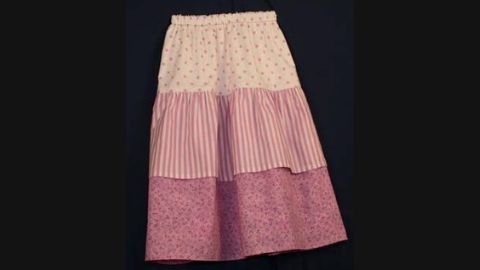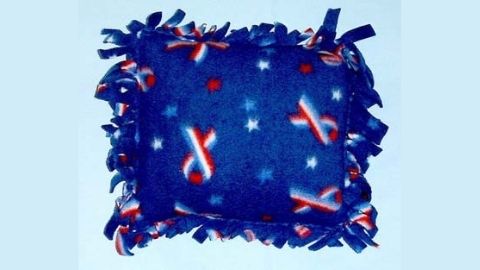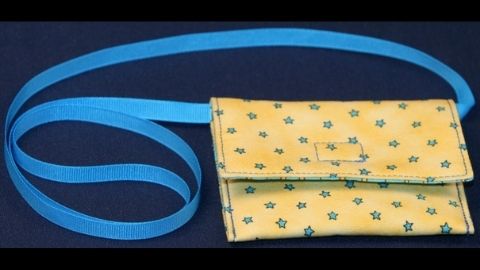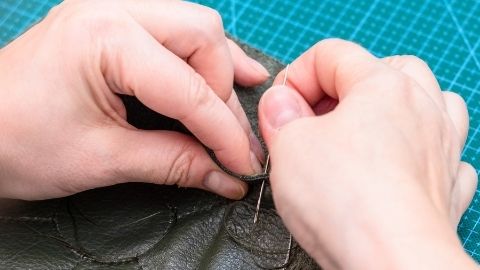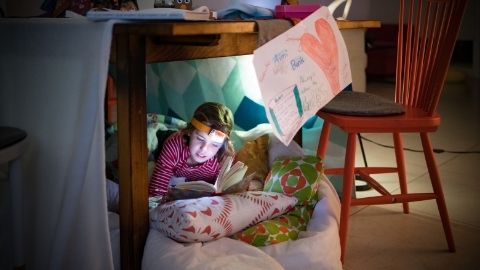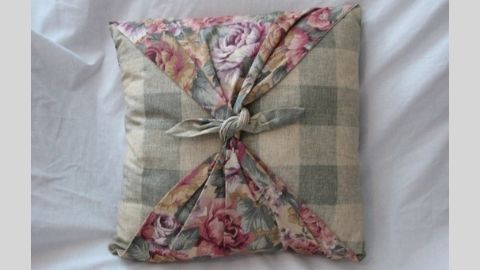Mitered Corner Blanket
Supplies needed:
- Two coordinating fabrics - see table below
- Select firmly woven, 100% cotton flannel or firmly woven cotton fabric or a combination
- Chalk wheel or pencil
- Ruler with 45º angle
- Pattern paper
- Thread to match
- Basic Sewing Supplies (see Fact Sheet: FL/ST/Construction 2007/101)
Blanket dimensions and amount of fabric needed:
| Fabric Required | |||
|---|---|---|---|
| Finished Size | Back and Border Edge | Feature Fabric | |
| Baby Receiving Blanket | 36" X 36" | 1 ⅜ yards 45" wide fabric | 1 ⅛ yards 45" wide fabric |
| Toddler Blanket OR Adult Lap Throw | 48" X 48" | 1 ¾ yards 60" wide fabric* | 1 ⅜ yards of 45" wide fabric |
* Note: Fabric width is not standard in measurement. If the fabric is 1 or 2 inches smaller than either the 45" wide fabric or the 60" wide fabric, the blanket will still work but will be smaller than the finished size. If 60" wide fabric is not available for back and border edge buy two lengths and piece them.
Fabric preparation:

Wash fabric before cutting to eliminate shrinkage and remove excess dye and lint. Press fabric.
Sewing clue — Woven fabric grainline is established by pulling a thread across the fabric from selvage edge to selvage edge. Clip ½" into the fabric along one selvage edge. Grasp one or two crosswise threads between your thumb and index finger and pull gently while pushing the fabric toward the other selvage edge with your other hand. Cut along the line left by the pulled threads. When the thread breaks cut to the end of the thread. Sometimes a single thread is easier to see on the wrong side of the fabric. When working with flannel the crosswise grain thread is not very strong. It is therefore easier to fray the fabric until a continuous thread runs the distance of the fabric.
Fold the fabric in half—matching the selvages and the newly straightened edges. The fabric should lie flat with the edges matching. If it does not lie flat, realign the fabric by holding the long edge of the fabric along the selvage edge and gently “pulling” the fabric on the bias as shown in Figure 1. This will realign the threads so that the crosswise threads run at right angles to the lengthwise threads.
Sewing clue - Becoming familiar with the markings in the Diagram Key will aid you in reading instructions. Most patterns have similar keys.
Pattern markings:
Diagram Key:

Right side of feature fabric

Wrong side of feature fabric

Right side of back fabric
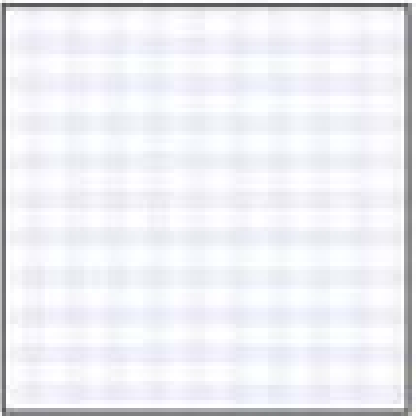
Wrong side of back fabric
----------------------------------------
stitching line
Blanket cutting instructions:
Step #1
- Cut two blanket squares. One square from the back and border edge and the other from the feature fabric—using the dimensions on the table labeled “Size of Square Blanket Pieces.” It is critical that these two pieces are square.
Sewing clue — The lengthwise grain of flannel does not stretch compared to the crosswise grain which has considerable stretch. Matching opposite grains of the cut squares assists in getting the finished blanket to lie smoothly.
When stitching, sew with the crosswise grain next to the feed dogs. This will help ease any excess fabric caused by stretching.
| Size of Square Blanket Pieces | |
|---|---|
| Back and Border Edge | Feature Fabric |
| 43" X 43" | 33" X 33" |
| 60" X 60" | 43" X 43" |
Matching opposite grains of the squares stabilizes the grain in the finished blanket. Using an even feed foot will also help.
Blanket construction:
Step #1
- Before beginning construction of your blanket check to make sure the back and feature fabric pieces are square.
- Identify the center of each side of the squares and mark with a pin.
- Lay the blanket back fabric on a flat surface with the right side up.
- Lay the feature fabric on top of the back fabric with right sides together. Match crosswise grain of feature fabric to lengthwise grain of back fabric.


Step #2
- Match the center of the raw edge of the two pieces. Pin the two pieces together at the center point.
- The border fabric should extend equal amounts beyond the feature fabric at both ends.
- Pin the raw edges of the two fabrics together.
Step #3
- Sew a ½" seam allowance along the pinned edge using a regular stitch length (12 stitches per inch or 2.5 stitches on the stitch length regulator). Start and stop stitching ½" from the end of the feature fabric. Back stitch the beginning and end to lock stitches securely.
Note: A ¼" seam allowance can be use for this project. If you choose to use the ¼" seam allowance your blanket will be slightly larger. Using the smaller seam allowance also eliminates the need to trim seams.

Step #4
- Match the center of the two pieces and the raw edge on the opposite side of the blanket. Follow the measuring process as outlined in Step #2.
- Sew a ½" seam allowance along the pinned edge using a regular stitch length. Start and stop ½" from the end of the feature fabric.
- Press seams flat to set stitches. Press seam allowances toward back fabric.
Sewing clue — To press, raise and lower the iron as you move across the fabric; use a gentle up and down motion. This will keep the grain of the fabric straight. Pushing the iron — back and forth — on the fabric is not recommended because it can stretch and distort the grain.
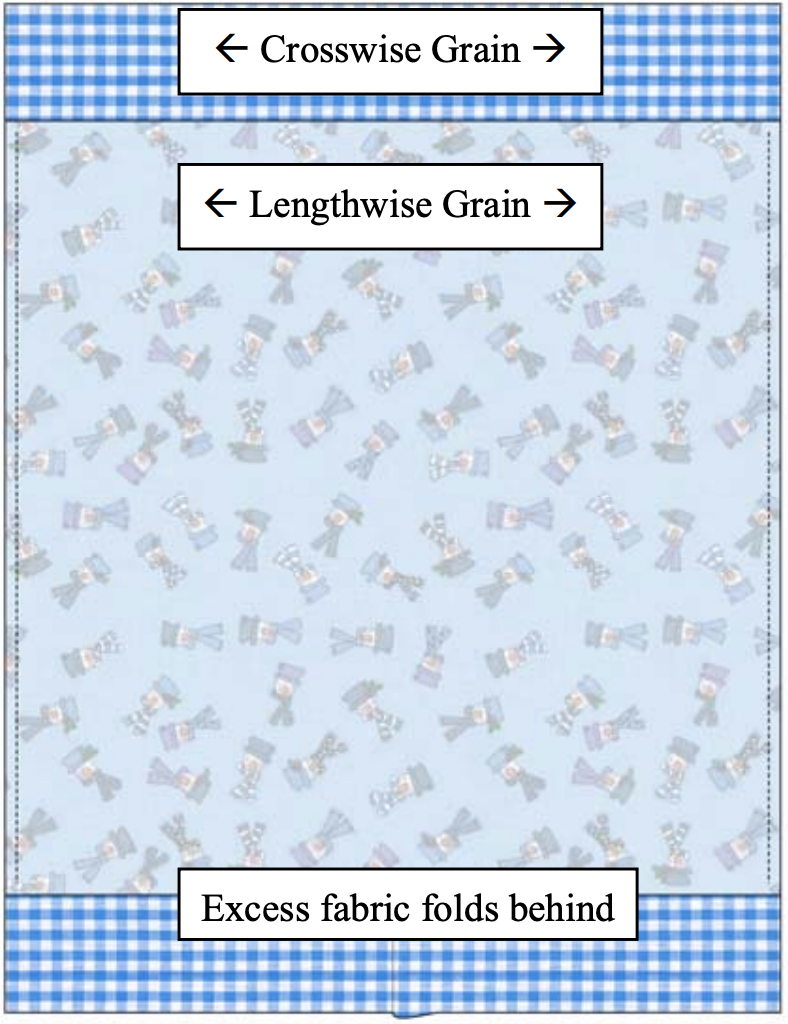
Step #5
- Pin the center of the raw edge of the feature fabric to the center of the raw edge of the back fabric. The back fabric will form a triangle.
- Hold the center point of the blanket in one hand. With the other hand grasp the point of the triangle and pull the raw edges taunt so that they match evenly.
- Pin the feature fabric to the back at the ½" stitching line. Repeat on the other side.
- Continue to pin the feature fabric to the back between the center pin and each stitching line pin.
- Pin each triangle along the raw edge from the point of the triangle to the ½" stitching line.

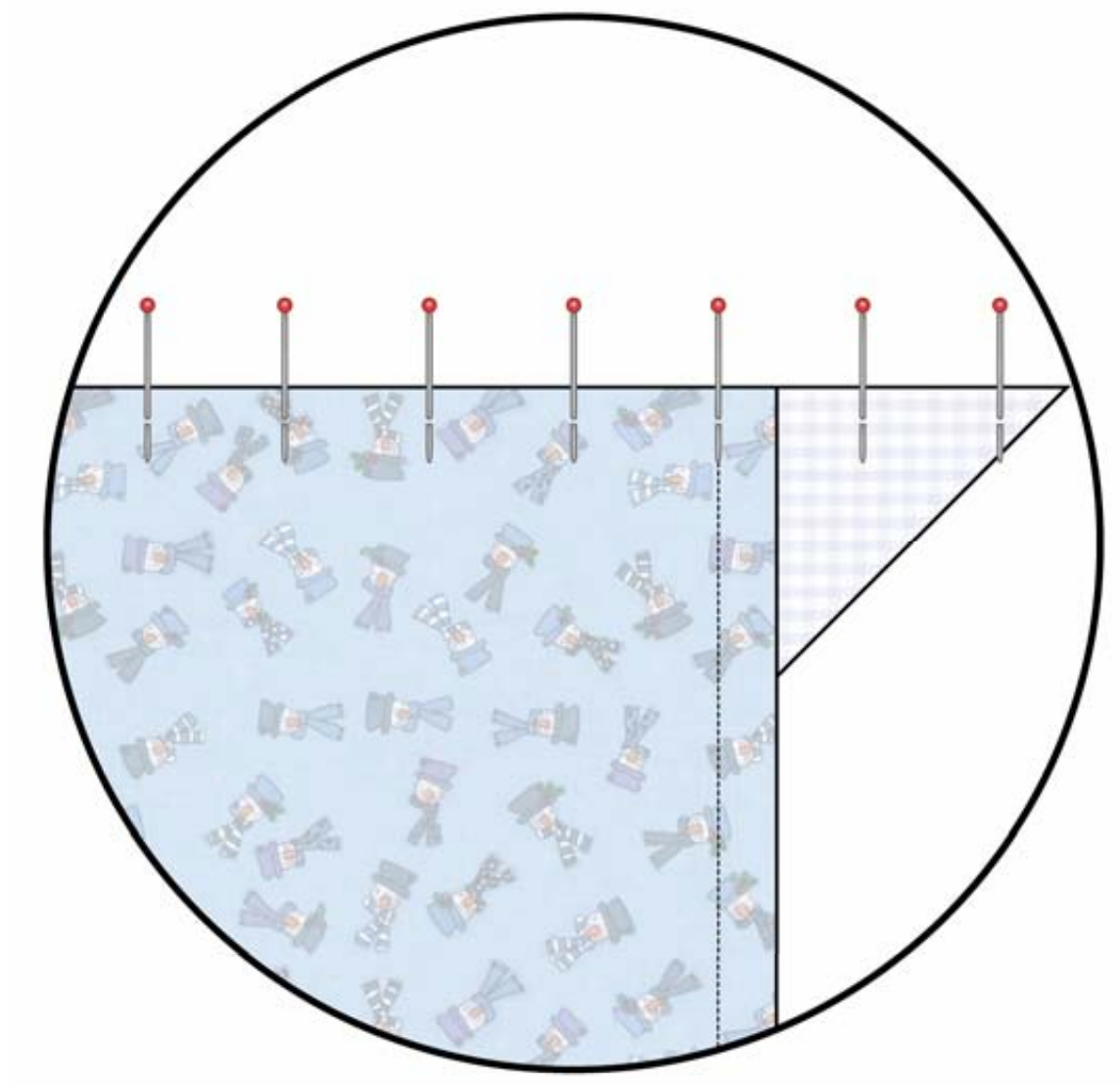
Step #6
- Sew a ½" seam allowance along the pinned edge using a regular stitch length. To insure accuracy, insert machine needle at the ½" stitching line point. Lower the pressure foot and sew to the other ½" stitching line point, ending exactly at the point. Backstitch at the beginning and end to lock stitches securely.
DO NOT SEW ACROSS THE TRIANGLE.
- Press seam flat to set stitches. Press seam allowance toward border.

Step #7
- Pin as in Step #5 on the other end of the blanket. Mark a 6" opening at the center for turning the blanket right side out.
- Sew as in Step #6 leaving the opening for turning. Backstitch at the beginning and end to lock stitches securely.
- Press seam flat to set stitches. Press seam allowance toward border.
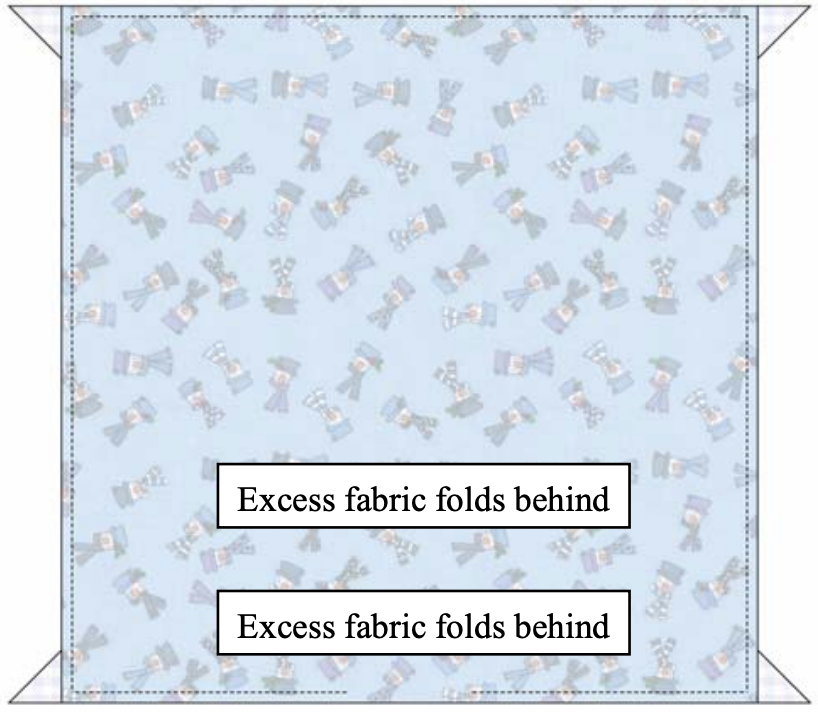
Sewing clue — To assist in keeping the seam allowance of the opening even, stitch to the opening point, back stitch and than change the stitch length to a basting stitch. Baste across the opening. Change the stitch length back to a regular stitch and back stitch. Continue sewing the seam to the stitching line point. To assist in removing the opening basting stitches clip them every ½". Press seam flat to set stitches. Press seam allowance toward border.
Mitered corner construction:
Step #1
- To create the mitered-corner, fold the blanket diagonally — matching raw edges and stitching lines. Make sure all layers lay flat at the point.
- Pin through all layers at the end of the ½" stitching points matching the stitching lines. Make sure the points match.

Sewing clue — Rulers with grids come in various lengths and widths and are marked with 45º angles.

Step #2
- Place the 45º angle of the ruler on the stitching line. The edge of the ruler will form a 90º angle with the folded edge of the blanket. Mark a stitching line with chalk starting at the stitching point and ending at the fold line.

Step #3
- Pin along the chalk line.

Step #4
- Starting at the end of the stitching line, sew along the 45º line toward the fold; back-stitch at the beginning and end to secure the stitching.
- Repeat on remaining corners.
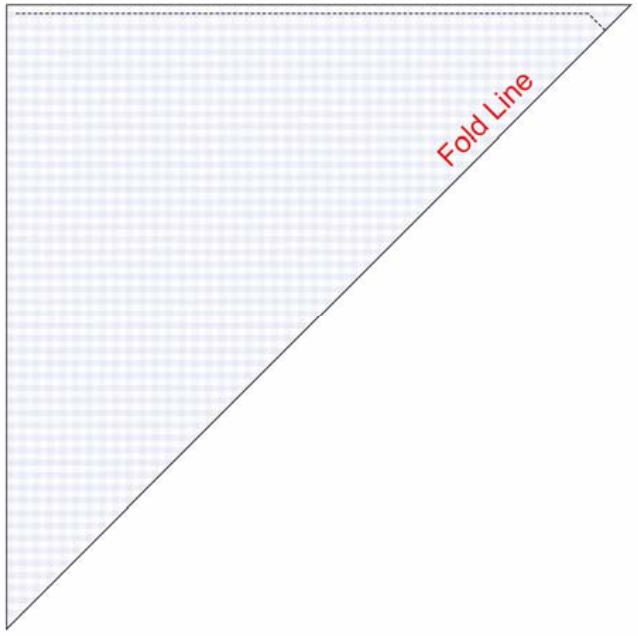
Step #5
- Trim end to ½" seam allowance. Trim the seam diagonally at the fold edge to reduce bulk at the point of the miter and notch at the point of the 45º angle.
Sewing clue — A notch is a wedge of fabric removed from an outside curve or corner to remove bulk. As the item is turned to the right side the notched edges will butt up against each other allowing the seam to lay flat.
- Press the 45º angle seams open.

Step #6
- Remove basting stitches from the opening.
- Turn the blanket right-side-out by pulling the right-side of the blanket through the opening.
Step #7
- Lay the blanket on a flat surface and smooth it out - making sure the seam allowances are turned toward the border and the miter corner allowance lays open flat.
- Measure the borders to make sure that they are all the same width. Pin to stabilize until sewn.
- Press flat.
- Switch next to the seam line (in the border allowance) and down each mitered seam to secure the border in place. A straight switch or decorative stitch works equally as well.

- Stabilize the blanket layers by sewing a square in the center.
- Make a square from the pattern paper to use as a guide to sew around. The square will vary in size proportionate with the size of the blanket. A center square 11" X 11" works well for the Baby Receiving Blanket. Use a 21" X 21" square for the Toddler or Adult Lap Throw
Authors
Debra Proctor, M.S., USU Extension Agent, Wasatch County; Ronda Olsen, M.S., USU Extension Agent, Uintah County; Carol Williams, M.S., USU Extension Agent, Piute/Wayne County; Karen Biers, Ph. D., USU Extension Specialist
Related Research


 Utah 4-H & Youth
Utah 4-H & Youth







